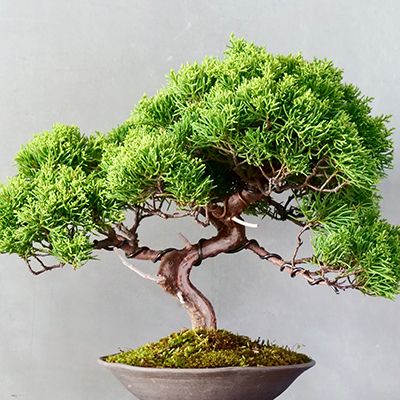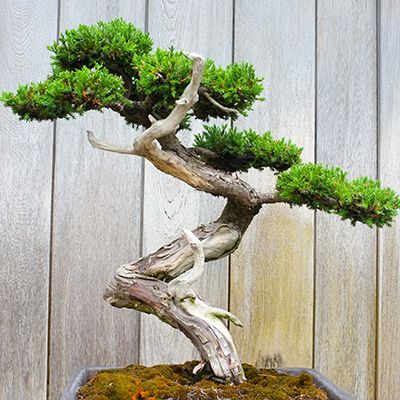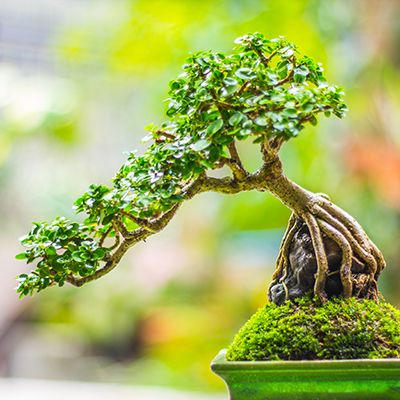


Bonsai
GENERAL GUIDELINES: Bonsai (pronounced Bone’-sigh) is the horticultural art of stunting a plant’s growth so that it appears to be a miniature of the normal plant. Generally, the plant is grown in a nutrient poor soil and only watered enough to keep it alive. For the beginner, best results are obtained by working with a slow growing plant or plant which normally will not grow to a great height (e.g., Japanese maple, juniper, Hawthorne).
WATERING: Softened water has too much salt for your plant’s health. Use rainwater or water which is not softened. Frequency of watering is somewhat dependent on weather conditions and placement—“Hetch Hetchy” water can be used directly. Thorough watering is recommended every one to three days in the spring, summer, and fall; less in the winter. Do not let the roots dry out completely. If it is very hot and/or windy, watering more than once a day may be necessary. It is best to water in the early morning or late afternoon. The method of watering should simulate natural rainfall—use an attachment on the watering can or hose which makes the spray soft enough so as not to disturb the soil. Water until excess water runs out from drainage holes from the bottom of the pot. In particularly hot, dry weather, or if you are not sure you are watering thoroughly enough, the pot can be placed in a shallow pan of cool standing water to one inch deep and soaked for up to one-half hour. Notice how heavy the pot is when it is thoroughly watered. The difference in weight between wet and dry will help you to know when the soil is dry, even if the top is moist.
FERTILIZING: A three to four month time release fertilizer such as Osmocote® Plus can be applied in the spring and again in the summer. Use fertilizer in moderation on ericaceous plants such as azaleas. For flowering and fruiting trees, feed with 0-10-10 fertilizer in the fall to winter-harden and improve next year’s display.
Our personal choice is to use Maxsea All Purpose Water Soluble Formula (16-16-16 plus micronutrients) at one-half strength from mid-February to October. If a tree has just been repotted, fertilize after it has had several weeks to adjust to its new soil.
OUTDOOR BONSAI: These are mostly deciduous and evergreen trees and shrubs from cool temperate climates, which have a definite dormant season. The ideal location is on a bench or table at a good viewing height, on a patio, deck or balcony, where the plant will have morning sun, afternoon shade, and shelter from drying winds. Avoid heat-reflective walls, and keep off the ground. Generally, outdoor bonsai can tolerate full sun most of the late fall, winter and early spring. Pines and junipers can take full sun year round, but will tend to yellow; for best color, shade them from hottest (mid-day to later afternoon) sun. Maples, azaleas, rhododendrons, and plants with delicate foliage should be placed in 50%-70% shade.
Turn the tree monthly for even lighting and growth; more frequently in the spring. Outdoor bonsai may be displayed indoors two to three days per month at the most, but keep them away from direct sunlight, fireplaces, and other heat sources.
WINTER PROTECTION: In mild winter areas, protect bonsai from winds and heavy winter storms by moving to a sheltered area. In cold winter areas, protect from hard frosts, but do not avoid winter dormant period by placing bonsai in a heated area. The bonsai can be heeled in to a protected flowerbed, cold frame or unheated basement, or in an enclosed, unheated porch.
INDOOR BONSAI: Indoor bonsai are usually evergreen tropical, sub-tropical and warm climate plants, which normally experience little if any dormant period. Winter air temperatures should range from 50° F at night to 75° F during the day for most sub-tropicals. Summer temperatures can be higher. Humidity should be fairly high. Placement in the kitchen, bathroom or on a saucer with a layer of pebbles and water will help raise the humidity. Adequate light may be found at an east or west window in the fall, winter or spring. In these locations, summer light is best filtered through a sheer curtain. Most bonsai plants do not perform well indoors. Low humidity and low light are the two main problems.
TRIMMING, PRUNING, TRAINING: Remove vigorous new growth in the spring and periodically throughout the growing season by cutting back to a point above a leaf or leaf pair. Never remove all the new growth at one time. Remove training wire (if any) after several months by snipping into short lengths. Do not allow wire to stay on the tree long enough to create scars. If the tree springs out of its wired shape, you can rewire it in the opposite direction, to avoid applying the wire in exactly the same place as before. Although copper wire is considered the best by many Bonsai Masters, aluminum is widely used and more available.
REPOTTING: Deciduous trees should be repotted every two-three years. Slower growing evergreens need repotting every four to five years.
Examine the root system in late fall to determine if the tree needs repotting. If repotting is required, plan to do it before the start of the next growing season. Always use a well-drained soil mix such as Master Nursery® Gardener’s Gold Potting Soil to which has been added one-quarter sharp sand (Builders Sand or #20 Sand) and one-eighth cat litter which makes the roots branch and keeps them vigorous.
PESTS AND DISEASES: Miniature bonsai can experience the same problems as their larger, full-size relatives, and should be treated with the appropriate insecticides or fungicides.
For further information see the 1994 edition of Sunset Bonsai.